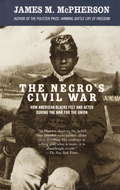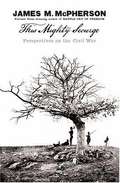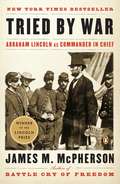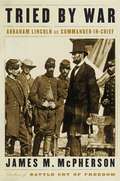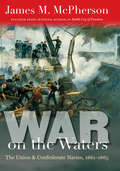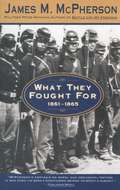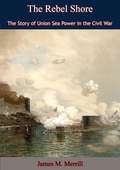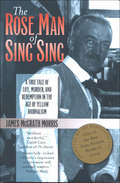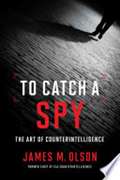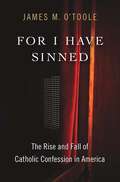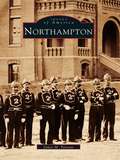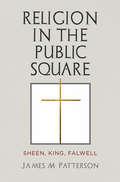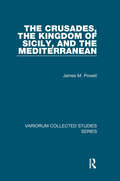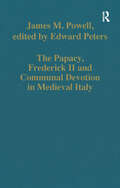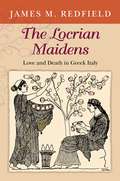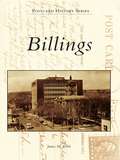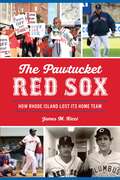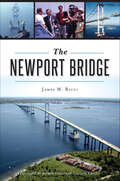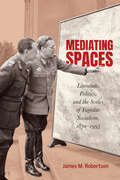- Table View
- List View
The Negro's Civil War
by James M. McphersonIn this classic study, Pulitzer Prize-winning author James M. McPherson deftly narrates the experience of blacks--former slaves and soldiers, preachers, visionaries, doctors, intellectuals, and common people--during the Civil War. Drawing on contemporary journalism, speeches, books, and letters, he presents an eclectic chronicle of their fears and hopes as well as their essential contributions to their own freedom. Through the words of these extraordinary participants, both Northern and Southern, McPherson captures African-American responses to emancipation, the shifting attitudes toward Lincoln and the life of black soldiers in the Union army. Above all, we are allowed to witness the dreams of a disenfranchised people eager to embrace the rights and the equality offered to them, finally, as citizens. From the Trade Paperback edition.
The Struggle for Equality: Abolitionists and the Negro in the Civil War and Reconstruction
by James M. McphersonHistory of abolition during the Civil War.
This Mighty Scourge: Perspectives on the Civil War
by James M. McphersonNow, in this collection of provocative and illuminating essays, McPherson offers fresh insight into many of the most enduring questions about one of the defining moments in our nation's history. McPherson sheds light on topics large and small, from the average soldier's avid love of newspapers to the postwar creation of the mystique of a Lost Cause in the South.
Tried by War
by James M. McphersonThe Pulitzer Prize?winning author reveals how Lincoln won the Civil War and invented the role of commander in chief as we know it As we celebrate the bicentennial of Lincoln?s birth, this study by preeminent, bestselling Civil War historian James M. McPherson provides a rare, fresh take on one of the most enigmatic figures in American history. Tried by War offers a revelatory (and timely) portrait of leadership during the greatest crisis our nation has ever endured. Suspenseful and inspiring, this is the story of how Lincoln, with almost no previous military experience before entering the White House, assumed the powers associated with the role of commander in chief, and through his strategic insight and will to fight changed the course of the war and saved the Union. .
Tried by War: Abraham Lincoln as Commander in Chief
by James M. McphersonJames McPherson, a bestselling historian of the Civil War, illuminates how Lincoln worked with - and often against - his senior commanders to defeat the Confederacy and create the role of commander in chief as we know it. Though Abraham Lincoln arrived at the White House with no previous military experience (apart from a couple of months spent soldiering in 1832), he quickly established himself as the greatest commander in chief in American history. James McPherson illuminates this often misunderstood and profoundly influential aspect of Lincoln's legacy. In essence, Lincoln invented the idea of commander in chief, as neither the Constitution nor existing legislation specified how the president ought to declare war or dictate strategy. In fact, by assuming the powers we associate with the role of commander in chief, Lincoln often overstepped the narrow band of rights granted the president. Good thing too, because his strategic insight and will to fight changed the course of the war and saved the Union. For most of the conflict, he constantly had to goad his reluctant generals toward battle, and he oversaw strategy and planning for major engagements with the enemy. Lincoln was a self-taught military strategist (as he was a self-taught lawyer), which makes his adroit conduct of the war seem almost miraculous. To be sure, the Union's campaigns often went awry, sometimes horribly so, but McPherson makes clear how the missteps arose from the all-too-common moments when Lincoln could neither threaten nor cajole his commanders to follow his orders. Because Lincoln's war took place within our borders, the relationship between the front lines and the home front was especially close - and volatile. Here again, Lincoln faced enormous challenges in exemplary fashion. He was a masterly molder of public opinion, for instance, defining the war aims initially as preserving the Union and only later as ending slavery - when he sensed the public was at last ready to bear such a lofty burden. As we approach the bicentennial of Lincoln's birth in 2009, this book will be that rarest gift-a genuinely novel, even timely, view of the most-written-about figure in our history. Tried by War offers a revelatory portrait of leadership during the greatest crisis our nation has ever endured. How Lincoln overcame feckless generals, fickle public opinion, and his own paralyzing fears is a story at once suspenseful and inspiring.
Tried by War: Abraham Lincoln as Commander in Chief
by James M. McphersonThe Pulitzer Prize?winning author reveals how Lincoln won the Civil War and invented the role of commander in chief as we know it As we celebrate the bicentennial of Lincoln?s birth, this study by preeminent, bestselling Civil War historian James M. McPherson provides a rare, fresh take on one of the most enigmatic figures in American history. Tried by War offers a revelatory (and timely) portrait of leadership during the greatest crisis our nation has ever endured. Suspenseful and inspiring, this is the story of how Lincoln, with almost no previous military experience before entering the White House, assumed the powers associated with the role of commander in chief, and through his strategic insight and will to fight changed the course of the war and saved the Union.From the Trade Paperback edition.
War on the Waters
by James M. McphersonAlthough previously undervalued for their strategic impact because they represented only a small percentage of total forces, the Union and Confederate navies were crucial to the outcome of the Civil War. In War on the Waters, James M. McPherson has crafted an enlightening, at times harrowing, and ultimately thrilling account of the war's naval campaigns and their military leaders. McPherson recounts how the Union navy's blockade of the Confederate coast, leaky as a sieve in the war's early months, became increasingly effective as it choked off vital imports and exports. Meanwhile, the Confederate navy, dwarfed by its giant adversary, demonstrated daring and military innovation. Commerce raiders sank Union ships and drove the American merchant marine from the high seas. Southern ironclads sent several Union warships to the bottom, naval mines sank many more, and the Confederates deployed the world's first submarine to sink an enemy vessel. But in the end, it was the Union navy that won some of the war's most important strategic victories--as an essential partner to the army on the ground at Fort Donelson, Vicksburg, Port Hudson, Mobile Bay, and Fort Fisher, and all by itself at Port Royal, Fort Henry, New Orleans, and Memphis.
What They Fought For, 1861-1865
by James M. Mcpherson<p>In Battle Cry Of Freedom, James M. McPherson presented a fascinating, concise general history of the defining American conflict. With What They Fought For, he focuses his considerable talents on what motivated the individual soldier to fight. <p> In an exceptional and highly original Civil War analysis, McPherson draws on the letters and diaries of nearly one thousand Union and Confederate soldiers, giving voice to the very men who risked their lives in the conflict. <p>His conclusion that most of them felt a keen sense of patriotic and ideological commitment counters the prevailing belief that Civil War soldiers had little or no idea of what they were fighting for. In their letters home and their diaries--neither of which were subject to censorship--these men were able to comment, in writing, on a wide variety of issues connected with their war experience. <p> Their insights show how deeply felt and strongly held their convictions were and reveal far more careful thought on the ideological issues of the war than has previously been thought to be true. <p>Living only eighty years after the signing of the Declaration of Independence, Civil War soldiers felt the legacy and responsibility entrusted to them by the Founding Fathers to preserve fragile democracy--be it through secession or union--as something worth dying for. <p> In What They Fought For, McPherson takes individual voices and places them in the great and terrible choir of a country divided against itself. The result is both an impressive scholarly tour de force and a lively, highly accessible account of the sentiments of both Northern and Southern soldiers during the national trauma of the Civil War. <P><P>[This text is listed as an example that meets Common Core Standards in History and Social Studies in grades 11-12 at http://www.corestandards.org.]
The Rebel Shore: The Story of Union Sea Power in the Civil War
by James M. MerrillFirst published in 1957, this book details the important part that the sea power played in winning the Civil War.“IN the past few decades there has been a resurgence of interest in the Civil War reflected in an avalanche of Civil War novels, biographies, and monographs. The writers responsible for this torrent have for the most part focused attention on the battlefields, the halls of Congress, the economics of war, and the actors, big and small. The role of sea power has been minimized. The best work on Civil War naval operations is still Boynton’s two-volume work published in 1867. No author to date has sifted the countless number of official naval dispatches or unearthed personal correspondence of Yankee bluejackets and attempted to evaluate the importance of Lincoln’s forces afloat. The reason is not difficult to find. The Civil War generation—a generation weaned on the marching armies of the Mexican War and the American West—read column after column in its newspapers and listened to politicians in and out of Congress raving about the military achievements or defeats. Misunderstood by the Lincoln Administration, the war correspondents, and the public at large, the operations of the Union sea arm were given scant publicity.“Union amphibious attacks spearheaded the offensive. They were, perhaps, more significant than the blockade itself. Old Abe’s Armada carried the flag first into the South, secured needed bases for the blockading squadrons, wiped out Confederate coastal commerce, scotched privateering activities, precipitated the ruckus between the secessionist states and the Confederate Government, and, throughout the first year of the conflict, while the Union Army licked its wounds after Bull Run, buoyed up a sagging Northern spirit and strengthened the belief that the Union could crush the rebellion.”
The Rose Man of Sing Sing: A True Tale of Life, Murder, and Redemption in the Age of Yellow Journalism (Communications and Media Studies #No. 8)
by James M. MorrisToday, seventy-three years after his death, journalists still tell tales of Charles E. Chapin. As city editor of Pulitzer’s New York Evening World , Chapin was the model of the take-no-prisoners newsroom tyrant: he drove reporters relentlessly—and kept his paper in the center ring of the circus of big-city journalism. From the Harry K. Thaw trial to the sinking of the Titanic , Chapin set the pace for the evening press, the CNN of the pre-electronic world of journalism. In 1918, at the pinnacle of fame, Chapin’s world collapsed. Facing financial ruin, sunk in depression, he decided to kill himself and his beloved wife Nellie. On a quiet September morning, he took not his own life, but Nellie’s, shooting her as she slept. After his trial—and one hell of a story for the World’s competitors—he was sentenced to life in the infamous Sing Sing Prison in Ossining, New York. In this story of an extraordinary life set in the most thrilling epoch of American journalism, James McGrath Morris tracks Chapin’s rise from legendary Chicago street reporter to celebrity powerbroker in media-mad New York. His was a human tragedy played out in the sensational stories of tabloids and broadsheets. But it’s also an epic of redemption: in prison, Chapin started a newspaper to fight for prisoner rights, wrote a best-selling autobiography, had two long-distance love affairs, and tapped his prodigious talents to transform barren prison plots into world-famous rose gardens before dying peacefully in his cell in 1930. The first portrait of one of the founding figures of modern American journalism, and a vibrant chronicle of the cutthroat culture of scoops and scandals, The Rose Man of Sing Sing is also a hidden history of New York at its most colorful and passionate.James McGrath Morris is a former journalist, author of Jailhouse Journalism: The Fourth Estate Behind Bars , and a historian. He lives in Falls Church, Virginia, and teaches at West Springfield High School.
The Faithful: A History of Catholics in America
by James M. O'TooleShaken by the ongoing clergy sexual abuse scandal, and challenged from within by social and theological division, Catholics in America are at a crossroads. But is today’s situation unique? And where will Catholicism go from here? With the belief that we understand our present by studying our past, James O’Toole offers a bold and panoramic history of the American Catholic laity. O’Toole tells the story of this ancient church from the perspective of ordinary Americans, the lay believers who have kept their faith despite persecution from without and clergy abuse from within. It is an epic tale, from the first settlements of Catholics in the colonies to the turmoil of the scandal-ridden present, and through the church’s many American incarnations in between. We see Catholics’ complex relationship to Rome and to their own American nation. O’Toole brings to life both the grand sweep of institutional change and the daily practice that sustained believers. The Faithful pays particular attention to the intricacies of prayer and ritual—the ways men and women have found to express their faith as Catholics over the centuries. With an intimate knowledge of the dilemmas and hopes of today’s church, O’Toole presents a new vision and offers a glimpse into the possible future of the church and its parishioners. Moving past the pulpit and into the pews, The Faithful is an unmatched look at the American Catholic laity. Today’s Catholics will find much to educate and inspire them in these pages, and non-Catholics will gain a newfound understanding of their religious brethren.
To Catch a Spy: The Art of Counterintelligence
by James M. OlsonThe United States is losing the counterintelligence war. Foreign intelligence services, particularly those of China, Russia, and Cuba, are recruiting spies in our midst and stealing our secrets and cutting-edge technologies. In To Catch a Spy: The Art of Counterintelligence, James M. Olson, former chief of CIA counterintelligence, offers a wake-up call for the American public and also a guide for how our country can do a better job of protecting its national security and trade secrets. Olson takes the reader into the arcane world of counterintelligence as he lived it during his thirty-year career in the CIA. <P><P>After an overview of what the Chinese, Russian, and Cuban spy services are doing to the United States, Olson explains the nitty-gritty of the principles and methods of counterintelligence. Readers will learn about specific aspects of counterintelligence such as running double-agent operations and surveillance. The book also analyzes twelve actual case studies to illustrate why people spy against their country, the tradecraft of counterintelligence, and where counterintelligence breaks down or succeeds. A “lessons learned” section follows each case study.
For I Have Sinned: The Rise and Fall of Catholic Confession in America
by James M. O’TooleThe remarkable story of how confession became a defining rite for American Catholics—and then, beginning in the 1970s, all but disappeared.For generations, American Catholics went faithfully to confession, admitting their sins to a priest and accepting through him God’s forgiveness. The sacrament served as a distinctive marker of Catholic identity, shaping parishioners’ views of their relationship to God, their neighbors, and the wider world. But starting in the 1970s, many abandoned confession altogether. Focusing on the experiences of both laypeople and priests, James M. O’Toole reconstructs the history of confession’s steady rise—and dramatic fall—among American Catholics.In the early United States, the Catholic Church grew rapidly—and with it, confession’s centrality. Although the sacrament was practiced unevenly for much of the nineteenth century, frequent confession became common by the early twentieth. Both priests and parishioners understood confession as a ritual crucial for the soul, while on a social level, it established Catholic distinctiveness within a largely Protestant country. Today, however, even faithful Catholics seldom confess. The reasons for this change, O’Toole reveals, include the emergence of psychology and other forms of counseling; the Church’s stance against contraception, which alienated many parishioners; and a growing sense of confession’s inability to confront social problems like structural racism, poverty, and sexism. Meanwhile, increasing recognition of sexual abuse within the Church further undermined trust in clergy as confessors.Sensitively attuned to the historical importance of confession, For I Have Sinned also suggests that, if the sacrament no longer serves the needs of US Catholics, the Church and its members might find new ways to express their ideals in the twenty-first century.
Northampton
by James M. ParsonsThe beauty of the Connecticut River Valley in Massachusetts has always left visitors groping for superlatives, and the town of Northampton--once dubbed "The Athens of the Connecticut Valley"--has lately experienced a renaissance. Interest in the city has only risen through the years, and an assessment of its prominence throughout history easily explains its consistent attraction. From its settling in 1654 to the present, Northampton has been a hotbed of activity, idealism, growth, and change. Walking the streets of Northampton at different times were revolutionaries like Daniel Shays, patriots like Joseph Hawley, religious visionaries like Jonathan Edwards, idealists like the members of the utopian community in Florence, and governors like Caleb Strong and future president Calvin Coolidge. Notables like Sojourner Truth, Alexander Graham Bell, and President Franklin Pierce came and left, but their influences have remained.
Religion in the Public Square: Sheen, King, Falwell
by James M. PattersonIn Religion in the Public Square, James M. Patterson considers religious leaders who popularized theology through media campaigns designed to persuade the public. Ven. Fulton J. Sheen, Dr. Martin Luther King Jr., and Rev. Jerry Falwell differed profoundly on issues of theology and politics, but they shared an approach to public ministry that aimed directly at changing how Americans understood the nature and purpose of their country. From the 1930s through the 1950s, Sheen was an early adopter of paperbacks, radio, and television to condemn totalitarian ideologies and to defend American Catholicism against Protestant accusations of divided loyalty. During the 1950s and 1960s, King staged demonstrations and boycotts that drew the mass media to him. The attention provided him the platform to preach Christian love as a political foundation in direct opposition to white supremacy. Falwell started his own church, which he developed into a mass media empire. He then leveraged it during the late 1970s through the 1980s to influence the Republican Party by exhorting his audience to not only ally with religious conservatives around issues of abortion and the traditional family but also to vote accordingly.Sheen, King, and Falwell were so successful in popularizing their theological ideas that they won prestigious awards, had access to presidents, and witnessed the results of their labors. However, Patterson argues that Falwell's efforts broke with the longstanding refusal of religious public figures to participate directly in partisan affairs and thereby catalyzed the process of politicizing religion that undermined the Judeo-Christian consensus that formed the foundation of American politics.
For All We Have and Are: Regina and the Experience of the Great War
by James M. PitsulaThe First World War profoundly affected every community in Canada. In Regina, the politics of national identity, the rural myth, and the social gospel all lent a distinctive flavour to the city’s experience of the Great War. For many Reginans, the fight against German militarism merged with the struggle against social evils and the “Big Interests,” adding new momentum to the forces of social reform, including the fights for prohibition and women’s suffrage.James M. Pitsula traces these social movements against the background of the lives of Regina men who fought overseas in battles such as Passchendaele and Vimy Ridge. Skillfully combining vivid detail with the larger social context, For All We Have and Are provides a nuanced picture of how one Canadian community rebuilt both its realities and myths in response to the cataclysm of the “war to end all wars.”
Anatomy of a Crusade, 1213-1221
by James M. PowellJames M. Powell here offers a new interpretation of the Fifth Crusade's historical and social impact, and a richly rewarding view of life in the thirteenth century. Powell addresses such questions as the degree of popular interest in the crusades, the religious climate of the period, the social structure of the membership of the crusade, and the effects of the recruitment effort on the outcome.
The Civilization of the West: A Brief Interpretation
by James M. PowellThe civilization of the West; a brief interpretation
The Crusades, The Kingdom of Sicily, and the Mediterranean
by James M. PowellIn this collection of studies by James M. Powell, two related centres of attention can be seen. One is the campaigns undertaken by western Europeans in the eastern Mediterranean, chiefly in the late twelfth and thirteenth centuries - the Crusades - the reasons for them and manner in which they were organized and promoted. The other is the Kingdom of Sicily under Frederick II, himself a Crusader, and its society and economy, including its Muslim population. A characteristic feature is the author's interest in ordinary participants and the attempt to get behind the generalizations of macro-historians to the extent that may be possible.
The Papacy, Frederick II and Communal Devotion in Medieval Italy (Variorum Collected Studies)
by James M. Powell edited by PetersOf the twenty-five essays in this volume, most were published between 1961 and 2013, but four are printed here for the first time. They represent the work of a great and original scholar in Mediterranean history whose unflagging interest in Frederick II and his world consistently led him out into broader fields, which he always viewed in original ways. In an age often called that of papal monarchy and secular-minded rulers, Powell found popes with complex agendas and extensive pastoral concerns, a rather more Christian Frederick II, the human personnel and mechanics of the Fifth Crusade, the sermons of the devout urban layman Albertanus of Brescia, and Muslims under Christian rule. His studies here assert a continuity between the pontificates of Innocent III and Honorius III as well as the pragmatic necessity that only secular rulers could launch and direct crusading expeditions. His interest in the northern Italian communes relates their devotional culture to the ideals of virtuous government and communal identity. The devotional culture of the communes was to be the subject of his next book, now unfinished; several parts of it could be rescued and are now included here.
The Locrian Maidens: Love and Death in Greek Italy
by James M. RedfieldAthens dominates textbook accounts of ancient Greece. But was it, for the Greeks themselves, a model city-state or a creative, even a corrupt, departure from the model? Or was there a model? This book reveals Epizephyrian Locri--a Greek colony on the Adriatic coast of Italy--as a third way in Greek culture, neither Athens nor Sparta. Drawing on a wide range of literary and archaeological evidence, James Redfield offers a fascinating account of this poorly understood Greek city-state, and in particular the distinctive role of women and marriage therein. Redfield devotes much of the book to placing Locri within a more general account of Greek culture, particularly with the institution of marriage in relation to private property, sexual identity, and the fate of the soul. He begins by considering the annual practice of sending two maidens from old-world Locris, the putative place of origin of the Italian Locrians, to serve in the temple of Athena at Ilion, finding here some key themes of Locrian culture. He goes on to provide a richly detailed overview of the Italian city; in a set of iconographic essays he suggests that marriage was seen in Locri as a life transformation akin to the eternal bliss hoped for after death. Nothing less than a general reevaluation of classical Greek society in both its political and theological dimensions, The Locrian Maidens is must reading for students and scholars of classics, while remaining accessible and of particular interest to those in women's studies and to anyone seeking a broader understanding of ancient Greece.
Billings
by James M. ReichBillings is sometimes called "The Magic City" for its rapid growth that seems to change the skyline overnight. Located in the heart of the Yellowstone Valley, it is Montana's largest city and the state's premier business destination. From 1900 to the 1960s--Billings's "Golden Years"--locals and tourists alike enjoyed a variety of hotels, fine restaurants, and retail and wholesale shopping, while businesses such as sugar and oil refineries, banking, and brewing kept the economy running. Surrounded by unparalleled natural splendor, Billings has always had the stark juxtaposition of a modern city set amid wilderness, as these vintage postcards attest.
Pawtucket Red Sox, The: How Rhode Island Lost Its Home Team (Sports)
by James M. RicciThe Pawtucket Red Sox were one of the country's premier AAA baseball teams, and for forty-five years they called Rhode Island home. In February 2015, a group of investors purchased the team from the widow of beloved owner Ben Mondor and longtime executives Mike Tamburro and Lou Schwechheimer. The group tried to keep the team in Rhode Island and move them to a new ballpark, first in Providence and then in Pawtucket. But building sports stadiums requires vision, political will and leadership. Through a series of political and financial missteps, the various plans collapsed, resulting in the announcement in August 2018 that the team would be moving to Worcester, Massachusetts. Join author James Ricci as he reveals how Rhode Island lost its revered team.
The Newport Bridge (Landmarks)
by James M. RicciNewport is a premier destination, but getting to the city has not always been easy.For three centuries, ferries crossed Narragansett Bay's East Passage. That all changed on June 28, 1969, the day the Newport Bridge opened, and it closed the last remaining gap between Aquidneck and Conanicut Islands. Proponents of the bridge persevered political squabbles and delays for twenty-five years following World War II to make it a reality. The longest suspension bridge in the region incorporated several new technologies and construction techniques and changed the face of Rhode Island. Author James Ricci details the trials and tribulations that produced an iconic bridge.
Mediating Spaces: Literature, Politics, and the Scales of Yugoslav Socialism, 1870–1995
by James M. RobertsonThroughout the twentieth century in the lands of Yugoslavia, socialists embarked on multiple projects of supranational unification. Sensitive to the vulnerability of small nations in a world of great powers, they pursued political sovereignty, economic development, and cultural modernization at a scale between the national and the global – from regional strategies of Balkan federalism to continental visions of European integration to the internationalist ambitions of the Non-Aligned Movement.In Mediating Spaces James Robertson offers an intellectual history of the diverse supranational politics of Yugoslav socialism, beginning with its birth in the 1870s and concluding with its violent collapse in the 1990s. Showcasing the ways in which socialists in Southeast Europe confronted the political, economic, and cultural dimensions of globalization, the book frames the evolution of supranational politics as a response to the shifting dynamics of global economic and geopolitical competition. Arguing that literature was a crucial vehicle for imagining new communities beyond the nation, Robertson analyzes the manuscripts, journals, and personal correspondence of the literary left to excavate the cultural geographies that animated Yugoslav socialism and its supranational horizons. The book ultimately illuminates the innovative strategies of cultural development used by socialist writers to challenge global asymmetries of power and prestige.Mediating Spaces reveals the full significance of supranationalism in the history of socialist thought, recovering a key concern for an era of renewed geopolitical contestation in Eastern Europe.
